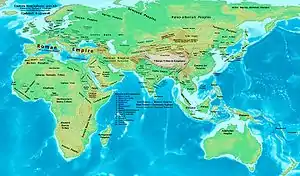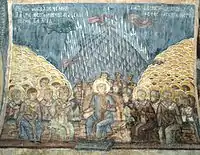4th century
The 4th century (per the Julian calendar and Anno Domini/Common era) was the time period which lasted from 301 (CCCI) through 400 (CD). In the West, the early part of the century was shaped by Constantine the Great, who became the first Roman emperor to adopt Christianity. Gaining sole reign of the empire, he is also noted for re-establishing a single imperial capital, choosing the site of ancient Byzantium in 330 (over the current capitals, which had effectively been changed by Diocletian's reforms to Milan in the West, and Nicomedeia in the East) to build the city soon called Nova Roma (New Rome); it was later renamed Constantinople in his honor.
| Millennium: | 1st millennium |
|---|---|
| Centuries: | |
| Timelines: | |
| State leaders: |
|
| Decades: | |
| Categories: | Births – Deaths Establishments – Disestablishments |


The last emperor to control both the eastern and western halves of the empire was Theodosius I. As the century progressed after his death, it became increasingly apparent that the empire had changed in many ways since the time of Augustus. The two emperor system originally established by Diocletian in the previous century fell into regular practice, and the east continued to grow in importance as a centre of trade and imperial power, while Rome itself diminished greatly in importance due to its location far from potential trouble spots, like Central Europe and the East. Late in the century Christianity became the official state religion, and the empire's old pagan culture began to disappear. General prosperity was felt throughout this period, but recurring invasions by Germanic tribes plagued the empire from 376[1][2] CE onward. These early invasions marked the beginning of the end for the Western Roman Empire.
In China, the Jin dynasty, which had united the nation prior in 280, began to quickly face troubles by the start of the century due to political infighting, which led to the opportunistic insurrections of the northern barbarian tribes (starting the Sixteen Kingdoms period), which quickly overwhelmed the empire, forcing the Jin court to retreat and entrench itself in the south past the Yangtze river, starting what is known as the Eastern Jin dynasty around 317. Towards the end of the century, Emperor of the Former Qin, Fu Jiān, united the north under his banner, and planned to conquer the Jin dynasty in the south, so as to finally reunite the land, but was decisively defeated at the Battle of Fei River in 383, causing massive unrest and civil war in his empire, thereby leading to the fall of the Former Qin, and the continued existence of the Eastern Jin dynasty.
According to archaeologists, sufficient archaeological evidence correlates of state-level societies coalesced in the 4th century to show the existence in Korea of the Three Kingdoms (300/400–668 CE) of Baekje, Goguryeo, and Silla.
Long Fourth Century
Historians of the Roman Empire refer to the "Long Fourth Century" to the period spanning the fourth century proper, but starting earlier with the accession of the Emperor Diocletian in 284 and ending later with the death of Honorius in 423 or of Theodosius II in 450.[3]
Events

- Early 4th century – Former audience hall now known as the Basilica, Trier, Germany, is built.
- 301: Armenia first to adopt Christianity as state religion.
- 304–439: The Sixteen Kingdoms in China begins.
- 306–337: Constantine the Great, ends persecution of Christians in the Roman Empire (see also Constantinian shift) and Constantinople becomes new seat of government (New Rome).
_-_Guatemala-1619.jpg.webp)
- 320: Butuan Boat One, the oldest known Balangay, a multi-purpose ship native to the Philippines is built.
- 325–328: The Kingdom of Aksum adopts Christianity.
- 325: Constantine the Great calls the First Council of Nicaea to pacify Christianity in the grip of the Arian controversy.
- 335–380: Samudragupta expands the Gupta Empire.
- 337: Constantine the Great is baptized on his death bed.
- 350: About this time the Kingdom of Aksum conquers the Kingdom of Kush.
- 350–400: At some time during this period, the Huns began to attack the Sassanid Empire.[2]
- 350: The Kutai Martadipura kingdom in eastern Borneo produced the earliest known stone inscriptions in Indonesia known as the Mulavarman inscription written in the Sanskrit language using Pallava scripture.[5]
- Mid-4th century – Dish, from Mildenhall, England, is made. It is now kept at the British Museum, London.
- Mid-4th century – Wang Xizhi makes a portion of a letter from the Feng Ju album. Six Dynasties period. It is now kept at National Palace Museum, Taipei, Taiwan, Republic of China.
- 365: An earthquake with a magnitude of at least eight strikes the Eastern Mediterranean. The following tsunami causes widespread destruction in Crete, Greece, Libya, Egypt, Cyprus, and Sicily.
- 376: Visigoths appear on the Danube and are allowed entry into the Roman Empire in their flight from the Huns.
- 378: Battle of Adrianople: Roman army is defeated by the Visigoth cavalry. Emperor Valens is killed.
- 378–395: Theodosius I, Roman emperor, bans pagan worship, Christianity is made the official religion of the Empire.
- 378: Siyaj K'ak' conquers Waka on (January 8), Tikal (January 16) and Uaxactun.
 Wall painting of the Council of Constantinople (381) in the Stavropoleos monastery, Romania
Wall painting of the Council of Constantinople (381) in the Stavropoleos monastery, Romania - 381: First Council of Constantinople reaffirms the Christian doctrine of the Trinity by adding to the creed of Nicaea.
- 383: Battle of Fei River in China.
- 395: The Battle of Canhe Slope occurs.
- 395: Roman emperor Theodosius I dies, causing the Roman Empire to split permanently.
- Late 4th century: Cubiculum of Leonis, Catacomb of Commodilla, near Rome, is made.
- Late 4th century: Atrium added in the Old St. Peter's Basilica, Rome.
Inventions, discoveries, introductions
- The Stirrup was invented in China, no later than 322.[6][1]
- Kama Sutra, dated between c. 400 BC to c. 300 AD.[7][8]
- Iron pillar of Delhi, India is the world's first Iron Pillar.
- Trigonometric functions: The trigonometric functions sine and versine originated in Indian astronomy.
- Codex Sinaiticus and the Codex Vaticanus Graecus 1209, are the earliest Christian bibles.[9][10]
- Book of Steps, Syriac religious discourses.
References
- The invention and influences of stirrup Archived 2008-12-03 at the Wayback Machine
- Roberts, J: "History of the World". Penguin, 1994.
- The Long Fourth Century 284-450: Continuity and Change in the Later Roman Empire ed. S. McGill, C. Sogno and E. Watts (Cambridge 2008).
- "The Maya: Glory and Ruin". National Geographic Magazine.
- "The Austronesians: Historical and Comparative Perspectives". ANU Press. Archived from the original on 2013-12-25. Retrieved 2013-04-29.
- Lee, Adela C.Y. "The stirrup and its effect on chinese military history". Silkroad Foundation.
- Sengupta, J. (2006). Refractions of Desire, Feminist Perspectives in the Novels of Toni Morrison, Michèle Roberts, and Anita Desai. Atlantic Publishers & Distributors. p. 21. ISBN 978-81-269-0629-1. Archived from the original on 4 May 2016. Retrieved 7 December 2014.
- Kakar, Sudhir; Doniger, Wendy (2003). Kamasutra. Oxford; Toronto: Oxford University Press. pp. xi. ISBN 978-0-19-283982-4.
- Aland, Kurt; Aland, Barbara (1995). The Text of the New Testament: An Introduction to the Critical Editions and to the Theory and Practice of Modern Textual Criticism. Erroll F. Rhodes (trans.). Grand Rapids, Michigan: William B. Eerdmans Publishing Company. p. 109. ISBN 978-0-8028-4098-1.
- "Liste Handschriften". Münster: Institute for New Testament Textual Research. Retrieved 16 March 2013.